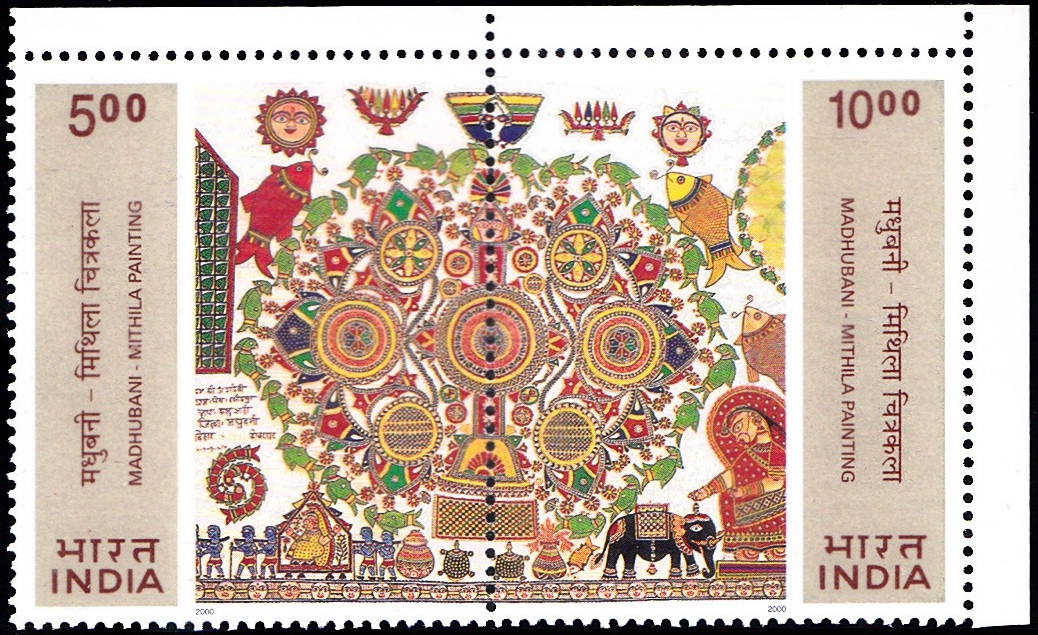
Mahatma Gandhi : Father of the Nation
A commemorative postage stamp on the 50 Years of the Republic of India :
Issued on Jan 27, 2000
Issued for : The Department of Posts commemorates the Golden Jubilee of the Republic of India with issue of a special/commemorative stamp paying tribute to Father of the Nation, Mahatma Gandhi. The stamp has been designed by eminent artist Shri Ranga, who was worked extensively on the theme of the life of Gandhiji, and portrayed very evocatively, various aspects of the life of the Mahatma and Gandhian thought. Since India attained Independence a large number of countries across the world, have honoured Mahatma Gandhi, through issue of commemorative postage stamps. The Department of Posts has over the years issued commemorative postage stamps, in honour of different aspects of Gandhian thought, and his leadership of the National Movement for Independence. A grateful and proud nation, on the 50th anniversary of the Republic of India, pays homage to the man, since his death universally acclaimed as the Father of the Nation through issue of this special commemorative stamp.
The first day cover design features Dr. B.R. Ambedkar who played the pivotal role in the drafting of the Constitution of India as chairman of the Drafting Committee and has been termed, the chief architect of the Indian Constitution. The Department of Posts pays tribute to Dr. B. R. Ambedkar‘s achievements in framing and piloting the Indian Constitution.
Credits :
Stamp : Ranga
FDC : Sankha Samantha
Cancellation : Alka Sharma
Type : Stamp, Postal Used
Colour : Multi Colour
Denomination : 300 Paise
Overall size : 3.34 x 2.88 cms.
Printing size : 2.99 x 2.53 cms.
Perforation : 13 x 13
Paper : un w/m Adhesive Gravure Coated stamp paper in sheet size 50.8 x 53.5
Stamps Printed : 1.4 Million
Number per issue sheet : 42
Printing Process : Photogravure
Printer : India Security Press, Nashik
About :
- “The Constituent Assembly which derived from the people …. All power and authority”, held its first session in December 1946 and the work of framing of the Constitution made rapid progress after India attained Independence. It was Dr. Bhimrao Ramji Ambedkar the chairman of the Drafting Committee who played the major role in framing of the Constitution. Dr. Ambedkar presented the final draft of the Constitution to the Constituent Assembly on 26th November, 1949. It was adopted on that day after Dr. Rajendra Prasad the President of the Constituent Assembly put it to vote. “Let us launch on this new enterprise of running our Independent Republic with confidence, with truth and non–violence and above all with heart within and God above”, with these hope inspiring words of the President, Dr. Rajendra Prasad, still ringing in their ears, the members of the Constituent Assembly in the name of the people of India, adopted, enacted and gave to themselves the Constitution, constituting India into a Sovereign, Democratic Republic.
- On 26th November, 1949, while replying to points raised by members of the Constituent Assembly regarding the Constitution, Dr. B.R. Ambedkar said “we must make our political democracy a social democracy as well. Political democracy cannot last unless there lies at the base of it social democracy. What does social democracy mean? It means the way of life which recognises liberty, equality and fraternity as the principles of life….”
- The Constitution embodied the aspirations of the Indian people and the ideals they had cherished during the struggle for freedom. Besides being the fountain-head of all laws in the country and prescribing a Parliamentary form of Government the Constitution was designed to be an instrument of India’s social and economic emancipation. The Constitution came in force on 26th January, 1950 the day which since 1930 had been observed every year as Independence Day. Dr. Rajendra Prasad was sworn in as the first President in the midst of unforgettable scenes of enthusiasm and rejoicing.
- Text : NCERT – ‘India’s Struggle for Independence’.








